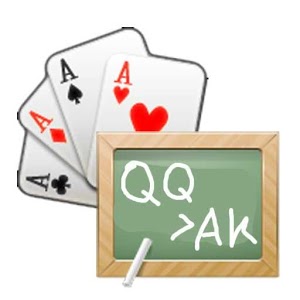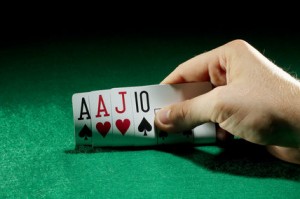Raising preflop, the combo float, and value-betting the river
It’s a $1-$2 blinds game, $5 to bring in. The big blind ($2,150) is a very loose-aggressive player preflop. You ($3,200) are dealt the Q Q
Q









1. Three players limp in front of you. You should:
a. Fold
b. Call
c. Raise
2. You raise to $35. The remaining players fold back to the big blind, who reraises to $120. The three limpers all fold. You should:
a. Fold
b. Call
c. Reraise
3. You call the reraise. You are heads up, and there is $256 in the pot. The flop comes J










a. Fold
b. Call
c. Raise
4. You call. There is $766 in the pot. The turn is the Q


a. Check
b. Bet
5. You bet $765. Your opponent calls, and there is now $2,296 in the pot. The river is the 6



a. Check
b. Bet $300
c. Bet $1,009 and set your opponent all in
Grades and Analysis
1. a(0), b(5), c(10)
You’ve got a big-and-middle two-pair hand with a suit, which is good enough to build the pot preflop.
2. a(0), b(10), c(2)
You definitely can’t fold, and it would be a disaster to four-bet here and get five-bet by A-A. This is especially true since you have the positional advantage; it would be a mistake to let your opponent five-bet and commit himself to the hand on the flop.
Calling is the best play.
3. a(2), b(10), c(7)
This is a pretty marginal situation all the way around, so I’ll spot you two points. And while none of your options are all that great, I think this situation calls for a combo float:
1. You might have the best hand.
2. You have position and deep enough stacks – with an effective stack-to-pot ratio (SPR) of around 8 (your opponent’s $2,030 stack divided by the $255 initial pot equals 7.96, or roughly 8), which equates to nearly two-and-a-half pot-sized bets left to play (a pot-sized bet on the flop and a call, a pot-sized bet on the turn and a call, leaving a nearly half-pot-sized bet on the river).
3. And even if you are behind, you have a live draw to at least the nut straight if not one of two sets, not to mention backdoor diamonds; you also have blocker draws should a straight card come.
With the stacks this deep, you don’t really want to raise here and have to face a reraise if wrong, as you are unlikely to get action from hands worse than yours for just under two-and-a-half bets (though I should note that you aren’t so deep that it would be a complete disaster, either). With an SPR greater than 13 (three bets left to play), calling would be the clear best choice, and with an SPR less than 4 (less than two bets), raising becomes the superior option (assuming that your opponent doesn’t necessarily have to have A-A or that he would fold A-A to a raise).
But with an SPR of 8, you are in judgment territory. My preference is to use the positional advantage, call, and keep the size of the pot down.
4. a(0), b(10)
You have both top set and a pair of nines for blockers, and your opponent has checked. The overwhelming probability is that your opponent doesn’t have the straight.
5. a(5), b(10), c(2)
The first question is whether or not you have the best hand.
As it stands, there are now two possible straights out, the only hands that can beat you. That said, I don’t see your opponent checking 10-9-X-X on both the turn and the river; if he actually had it, it is far more likely that even if he had checked the turn with it, he would have check-raised all in on the turn. And failing that, it is hard to see him checking the river, as it is too easy for you to check behind and show down something like two pair.
I also find it difficult for your opponent to show up with 7-5-X-X for the smaller straight, because even if he had something like 7-6-5-X, he would have to have called on the turn despite the obvious bigger straight already out.
So, at this point, I think it’s pretty clear that you have the best hand, and are almost definitely betting.
The next question is, “How much?” With regard to the bet size, you have two choices: make a token value-bet and hope to draw a weak call, or bet half the pot and set your opponent all in.
My concern with the bigger bet is that it looks too much like a straight. The way the hand has played out, it would be difficult for your opponent to call a $1,000-plus bet no matter what he has. On the other hand, your opponent might have had something like A-A with the nut-flush draw or two pair, and be willing to call a smaller bet if only for curiosity’s sake.
In the actual hand, I bet $300 – an almost ridiculous amount, at about 13 percent of the size of the pot. My opponent called, and my set of queens took down the pot.
This article was originally written by Jeff Hwang. Jeff Hwang is a semiprofessional player and author of Pot-Limit Omaha Poker: The Big Play Strategy. His latest book is Advanced Pot Limit Omaha Vol.1 and will be releasing Vol 2.
Submit your review | |






